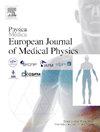基于个性化数据驱动的计算机断层扫描生成的乳腺放射治疗中深度吸气屏气的预先患者选择策略
IF 3.3
3区 医学
Q1 RADIOLOGY, NUCLEAR MEDICINE & MEDICAL IMAGING
Physica Medica-European Journal of Medical Physics
Pub Date : 2025-04-26
DOI:10.1016/j.ejmp.2025.104964
引用次数: 0
摘要
背景目前还没有广泛使用的预先选择方法来确定患者是否适合在左侧乳房放射治疗中进行深度吸气屏气(DIBH)。目的建立一种预先选择患者的策略,以提高DIBH的决策效率,避免患者额外的CT暴露。方法共纳入174例同时进行自由呼吸(FB)和DIBH扫描的患者。训练了DIBH-CT合成的通用主成分分析模型,该模型由训练集中从配对的FB-CT和DIBH-CT中提取的主成分特征向量组成。优化矢量系数,使合成CT与测试集中每个患者屏气侦察图像的差异最小化,实现个性化的DIBH-CT合成。在综合DIBH-CT计划中建立了基于心脏剂量的预先患者选择策略。根据合成的和扫描的DIBH-CT的几何和剂量一致性来分析合成的DIBH-CT的性能。评估患者选择策略的准确性。分析了患者选择工作流程的时间假设。结果合成dibh - ct与扫描dibh - ct相比,心脏和肺部的平均Dice相似系数分别为0.84和0.91。合成DIBH-CT方案显示平均心脏剂量减少1.46 Gy,与扫描DIBH-CT方案的1.51 Gy无显著差异(p = 0.878)。患者选择策略获得了正确的获益结果,准确率为86.7%。患者选择的平均时间为11.9±3.6 min。结论所提出的患者选择策略可以准确识别从DIBH获益的患者,并为DIBH提供了更高效的工作流程。本文章由计算机程序翻译,如有差异,请以英文原文为准。
An upfront patient selection strategy based on personalized data-driven computed tomography generation for deep inspiration breath-hold in breast radiotherapy
Background
Currently there is no widely used upfront selection method to determine whether patients are suitable for deep inspiration breath-hold (DIBH) in left-sided breast radiotherapy.
Purpose
To establish an upfront patient selection strategy to improve the decision-making efficiency of DIBH and avoid extra computed tomography (CT) exposure to patients.
Methods
A total of 174 patients who underwent both free-breathing (FB) and DIBH scans were enrolled. A general principal component analysis model for DIBH-CT synthesis was trained and consists of principal component feature vectors extracted from paired FB-CT and DIBH-CT in training set. The coefficients of the vectors were optimized to minimize the difference between synthetic CT and breath-hold scout image of each patient in test set, leading to personalized DIBH-CT synthesis. An upfront patient selection strategy was established based on cardiac dose in synthetic DIBH-CT plan. The performance of DIBH-CT synthesis was analyzed in terms of geometric and dosimetric consistency between synthetic and scanned DIBH-CTs. The accuracy of the patient selection strategy was evaluated. Time assumption of the patient selection workflow was analyzed.
Results
Synthetic DIBH-CTs had average Dice similarity coefficients of 0.84 for the heart and 0.91 for the lungs compared with scanned DIBH-CTs. Synthetic DIBH-CT plans revealed an average mean heart dose reduction of 1.46 Gy, which was not significantly different from 1.51 Gy in scanned DIBH-CT plans (p = 0.878). The patient selection strategy yielded the correct benefit results with accuracy of 86.7 %. The average time assumption for patient selection was 11.9 ± 3.6 min.
Conclusions
The proposed patient selection strategy can accurately identify patients benefiting from DIBH and provides a more efficient workflow for DIBH.
求助全文
通过发布文献求助,成功后即可免费获取论文全文。
去求助
来源期刊
CiteScore
6.80
自引率
14.70%
发文量
493
审稿时长
78 days
期刊介绍:
Physica Medica, European Journal of Medical Physics, publishing with Elsevier from 2007, provides an international forum for research and reviews on the following main topics:
Medical Imaging
Radiation Therapy
Radiation Protection
Measuring Systems and Signal Processing
Education and training in Medical Physics
Professional issues in Medical Physics.

 求助内容:
求助内容: 应助结果提醒方式:
应助结果提醒方式:


